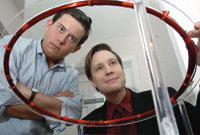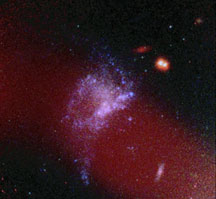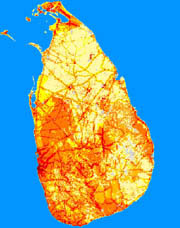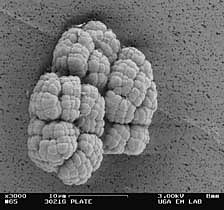Research
Highlights...
|
|
William Thompson, left, and Argonne 's Rex Gerald have been collaborating on research since William was 12. |
|
 |
| Number 175 |
January 17, 2005 |
|
Solar installation approved for Beijing Olympics
Researchers at DOE's National Renewable Energy Laboratory participated in a recent Green Beijing Olympics meeting that resulted in an agreement between the United States and China to cooperate on a 100-kilowatt photovoltaic installation for the 2008 Olympics. Green Olympics means priority will be given to environmental protection in the planning, designing and construction of Olympic venues and facilities. The objective of the project is to use solar cells to provide a significant portion of the electricity that will be consumed at either the Olympic Gymnasium or the Olympic Village. DOE and NREL have agreed to provide technical assistance for this project.
[Sarah Holmes Barba, 303/275-3023,
sarah_barba@nrel.gov]
|
|
Black-hole jets may induce star formation
|
This false-color image incorporates infrared data (invisible to the human eye). The blue regions (essentially the whole of Minkowski's Object) show enhanced star formation. The red background galaxy and two red foreground stars appear in sharp contrast. The red overlay is the radio jet. |
Astronomers have discovered how ominous black holes can create life in the form of new stars, proving that jet-induced star formation may have played an important role in the formation of galaxies in the early universe. Using the Very Large Array at the National Radio Astronomy Observatory in New Mexico, the Keck telescopes in Hawaii and the Hubble Space Telescope, DOE Lawrence Livermore National Laboratory astronomers Wil van Breugel and Steve Croft have shown that “Minkowski's Object,” a peculiar starburst system in the NGC 541 radio galaxy, formed when a radio jet – undetectable in visible light but revealed by radio observations – emitted from a black hole collided with dense gas. The researchers carried out the observations after computer simulations at Lawrence Livermore by Chris Fragile, Peter Anninos and Stephen Murray had shown that jets may trigger the collapse of interstellar clouds and induce star formation.
“Some 20 years ago this kind of thinking was thought to be science fiction,” said van Breugel, who along with Croft works at the Laboratory's Institute for Geophysics and Planetary Physics. “It brings poetic justice to black holes because we think of them as sucking things in, but we've shown that when a jet emits from a black hole, it can bring new life by collapsing clouds and creating new stars.” [Anne Stark, 925/422-9799,
stark8@llnl.gov]
|
|
Mapping technology aids tsunami recovery
| |
LandScan image of Sri Lanka shows population densities along hard-hit east coast. |
Relief agencies working to assist victims of the are using a demographic database developed at DOE's Oak Ridge National Laboratory. LandScan is a global population database that shows geographical distribution of population at one-kilometer resolution. Using population distribution maps, relief workers can easily and quickly determine the locations of potential tsunami victims who would otherwise be cut off from communication.
The database system is being used to identify spatial and population numbers in the impacted tsunami areas, down to the square kilometer.
Before the disaster, LandScan data was used to plan aid and recovery efforts after the 2003 earthquake that destroyed Bam, Iran.
[Ron Walli, 865/576-0226,
wallira@ornl.gov]
|
|
Tunnel facility shed light on CO2 in cold water
Researchers at DOE's National Energy Technology Laboratory presented valuable data on CO2 behavior in cold aqueous systems based on research conducted using the High-Pressure Water Tunnel Facility. A focus of the research is deriving CO2 solubility information and mass transfer coefficients by measuring dissolution of CO2 in seawater at various levels of dissolved CO2. The data are critical in understanding the thermal, physical, and thermodynamic behavior of CO2 under the conditions anticipated in deep-ocean sequestration scenarios, and will help scientists understand the formation mechanism of CO2 hydrate and the ultimate fate of sequestered CO2 in deep-ocean conditions.
[Linda Morton, 304/285-4543,
Linda.morton@netl.doe.gov]
|
|
|
Student-scientist collaboration illuminates future
|
|
William Thompson, left, and Argonne 's Rex Gerald have been collaborating on research since William was 12.
|
When Rex Gerald, at chemical physicist at DOE's Argonne National Laboratory, first met William Thompson at a regional science fair, the tall, serious, and reserved eighth grader made an immediate impression on Gerald. “My initial thoughts about William were that he was a bit defensive and arrogant,” Gerald said. “He probably had a similar opinion of me.”
Maybe the perceived arrogance was really just confidence. After all, William had a reason to be confident. His project achieved the Best in Physics award at the Chicago Regional Science Fair.
On June 5, 2004 , more than two years and handfuls of science awards later, Thompson and Gerald were honored for their work.
William, now a high school junior at St. Ignatius College Preparatory School in Chicago , received the ComEd 100 Science Award for his work with toroid cavities. The award honors students who exhibit a strong interest in science and develop an exemplary scientific project.
The program also recognizes leading mentors who actively support these students. Gerald received one of five Illinois statewide Illuminator Awards, after William nominated him.
William's collaboration with Gerald has most recently centered on nuclear magnetic resonance, which allows researchers to obtain information about the physical, chemical and electronic properties of molecules in complex systems.
“It can determine the flavor of a jelly bean and the color of a jelly bean based solely on the properties of the response,” William said. “Rex brought me into this esoteric field and taught me NMR, how to use the device, and the whole science behind it.”
In his essay nominating Gerald for the Illuminator Award, William wrote: “Dr. Gerald is a gifted scientific intellectual and an intrepid scientific researcher, explorer and inventor, is axiomatic. What is not readily known is his unique gift for encouraging young scientists to persevere in the face of inevitable experimental failures, challenging them to think ‘outside the box,' or the confines of orthodoxy, to find the answers to surmounting the obstacles that loom so large in front of them.”
Submitted by DOE's
Argonne National Laboratory
|
|




